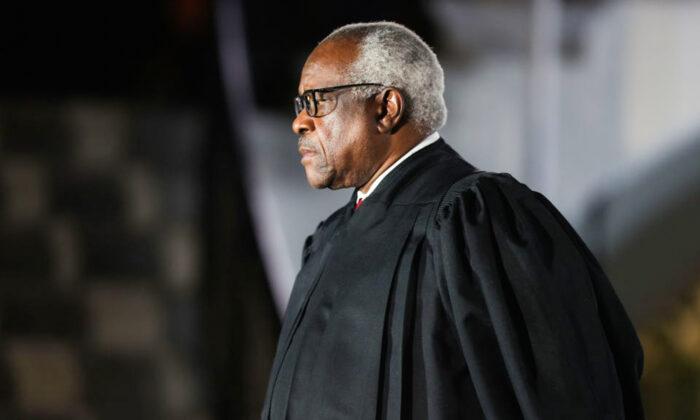Justice Clarence Thomas frequently uses concurring and dissenting opinions to explain the Constitution’s fundamental principles.
Congress’s Legitimate Spending Power
The Constitution enumerates (lists) the powers held by Congress and other branches of the federal government. A basic constitutional principle—which the Supreme Court honors more in words than in reality—is that those powers are limited to the items enumerated.To carry out its enumerated powers, Congress must appropriate money. By way of illustration, if Congress chooses to “regulate Commerce with foreign Nations” (Article I, Section 8, Clause 3), it must pay customs officers, provide them with equipment and supplies, and finance office space for them. Similarly, Congress’s power to “raise and support Armies” (Article I, Section 8, Clause 12) necessarily includes spending money for salaries, equipment, housing, transportation, and so forth.
Almost every enumerated power implicitly contains some authority to spend.
The Metastasis of the Spending Power
Among Congress’s enumerated powers is the taxation clause (Article I, Section 8, Clause 1). This also includes some spending authority: To collect taxes, the federal government must be able to spend so as to pay, equip, and house tax collectors.The taxation clause adds to the phrase “lay and collect Taxes” the following additional wording: “to pay the Debts and provide for the Common Defence and general Welfare of the United States.” This addition is called the general welfare clause.
The purpose of the general welfare clause is to limit the taxing power. It clarifies that Congress may raise money only for “general Welfare” purposes, not to feed special interests.
Specifically, the court converted the general welfare clause from a restriction on taxes into an unlimited “spending clause.” The justices’ opinions ignored almost all the evidence from the Constitution’s adoption. Among Founding-era materials, they relied solely on a paper issued by Alexander Hamilton after the Constitution had been adopted. At the time, Hamilton was—according to his private notes—trying surreptitiously to convert the federal system into one with an all-powerful central government.
The court’s decisions had predictable results. Federal expenditures exploded. Congress usually stopped balancing its budget and accrued massive debt. Members of Congress used their unlimited spending power to buy reelection, enabling some to stay in Congress for as long as 50 years. Congress created a massive bureaucracy to address details it didn’t have time or inclination to address.
The Court’s Opinion in the Talevski Case
The federal program at issue in the Talevski case was the payment of Medicaid funds to nursing homes. The government imposes a very long list of conditions on that payment, including rules for how nursing homes treat their patients—as if most federal politicians knew anything about health care!Talevski’s family claimed that a county-owned nursing home had violated one of those conditions. Using a post-Civil War federal statute, 42 U.S.C., sec. 1983, they claimed that the nursing home had denied Talevski certain “rights, privileges, or immunities ... secured by [federal] laws.”
The Supreme Court agreed with the Talevskis. By a 7–2 majority, the justices ruled that some of the conditions on federal payment were “laws” that “secured rights.” The opinion was written by Justice Ketanji Brown Jackson.
Justice Samuel Alito dissented on technical grounds, and Thomas agreed with him.
The Thomas Dissent
Thomas’s fundamental point was this: When Congress offers a financial grant in an area outside its enumerated powers (such as a grant to nursing homes), Congress may impose conditions. Anyone accepting the money accepts the conditions. But those conditions are merely terms in a contract between the federal government and the grantee. They aren’t “laws” as the word is employed in 42 U.S.C. sec. 1983.In his 36-page dissenting opinion, Thomas recounted the history of Congress’s spending power. He showed how the power—as expanded by the Supreme Court—has grown to largely dominate American life. He explained how it has rendered the states merely “disaggregated sites of national governance, not separate sovereigns.”
He recognized the published research by several scholars who have explored Congress’s spending power in detail. In their personal political views, these scholars largely span the political spectrum. But all have been honest enough to admit that the court was wrong when it converted the general welfare clause into unlimited spending authority.
The first one to write on the subject was David Engdahl of Seattle University. He was followed by Jeff Renz, who wrote an important article on the subject while serving with me on the law faculty at the University of Montana. Next came John Eastman, formerly dean of Chapman University’s law school. Eastman, who as a young law graduate clerked for Thomas, is the same man that the FBI harassed because he provided legal advice to Donald Trump after the 2020 election. In a 2001 article, Eastman explained that the general welfare clause was designed as a curb on congressional pandering to special interests.
Conclusion
Thomas’s separate opinions contain a wealth of information about the Constitution’s original meaning, how the document was applied in later years, and the scholarship on the subject.When he retires, some enterprising author will no doubt collect these opinions into a single volume or set of volumes. They'll be an invaluable resource for future generations.





